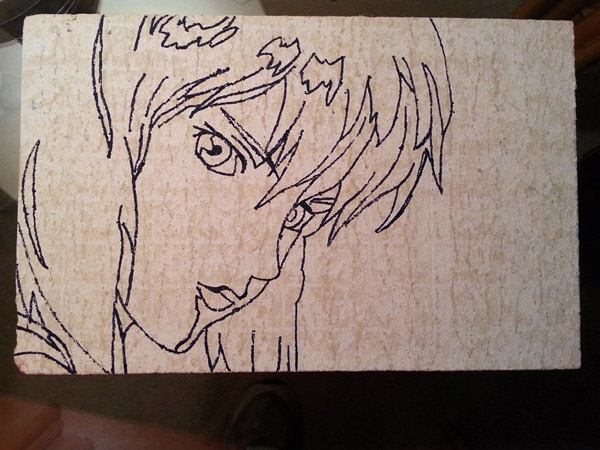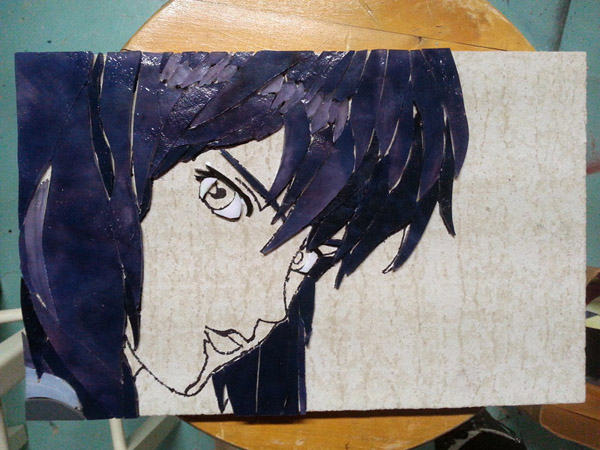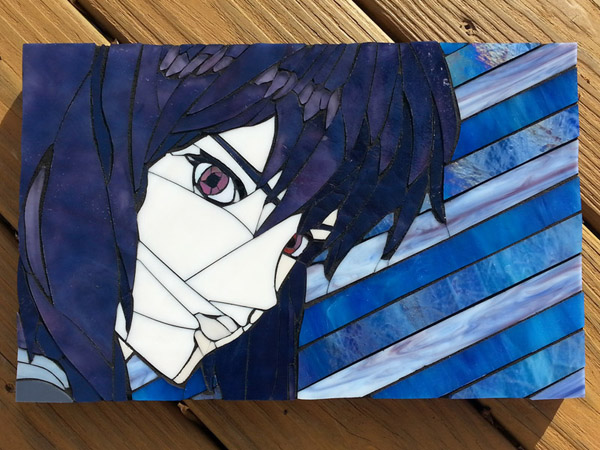What to use for a backer is determined by how the mosaic will be displayed. For example, you could use a piece of sanded plywood as a backer for a small mosaic plaque or trivet, but you could NOT use plywood as backer for a mosaic floor because wood is compressible. Similarly, you could NOT use plywood as a backer for an outdoor mosaic or wet mosaic because plywood warps over time due to changes in humidity.
We have some additional recommendations for choosing a backer based on how the mosaic will be displayed.
Concrete Backer Board
The best all-around mosaic backer is concrete backer board, such as that used in bathrooms as the sub-floor for tile floors. Concrete backer board is cheap, cuts easily, comes in 1/4″ and 1/2″ thick sheets, and is available at almost any building material store. Drywall can be removed easily and replaced with a sheet of concrete backer board. The 1/2″ thickness is recommended for floors, and we only use the 1/4″ size when laminating it to plywood.
Using Concrete Backer Board for Wall Art or Plaques
A small piece of concrete backer board can be used to strengthen a piece of hanging wall art or a plaque. 1/4″ backer board can be laminated to a piece of plywood and then the edges sanded with a belt sander (wear a mask!) to make the sides look even. The backer board will provide a rigid and waterproof layer for the mosaic to rest on while the plywood behind it can be used to anchor the screws in that are needed for the hanging wire.

Mosaic artist Natalija Moss began this mosaic by laminating a piece of 1/4″ backer board to a piece of plywood. She used Weldbond mosaic glue and some clamps to laminate the plywood to the backerboard over night. Then she drew the pattern for the mosaic using a marker onto the backer board side of the piece.

Using the direct method, Natalija then started cutting and gluing pieces of stained glass directly to the backer board surface. Backer board may bond to the glue more quickly than other surfaces such as plywood, so make sure you have your pieces exactly where you want them or you may have to scrape them off with a flathead screwdriver which could damage nearby tiles, especially stained glass. Always wear safety glasses when mosaicing, but especially if you find yourself scraping off tiles.

The finished piece. There are two screws in the back of the plywood with a hanging wire tied to them. The plywood behind the backer board is about 1/2″ thick so she used short screws so as not to penetrate the backer board and damage the mosaic. It is also possible to cut a keyhole slot using a plunge router, but that should be done at the beginning before any glass is put down.
Durable, Strong, Inflexible, and Clean
Mosaic backings should be durable, strong, inflexible and clean.
Durable
Durable means resistant to water and moisture. Over the years, humidity in the air can turn plywood and particle board into splinters. Long before this happens, the tiles will begin popping off as the plywood warps. MDF and particle board swell and disintegrate with humidity as well. Avoid using wood products of any type outdoors. If you have to use wood outdoors, then use marine plywood, and make sure you paint the undersides and side edges with multiple coats of exterior paint and seal the finished mosaic.
All that being said, plywood can be used for dry indoor mosaics such as small plaques, picture frames and mirrors. If you make an indoor mosaic picture on plywood larger than 2 feet wide, then you should still paint the underside and sides to keep humidity from warping the plywood over time.
Strong
Mosaic materials are heavy, no matter if you are using stone, ceramic or glass mosaic tile. Grout is concrete. The weight of even one square foot of mosaic can be heavy. This means that not only your backer must be strong but also your points of attachment. (Never hang a mosaic from a single nail like a painting.) Mosaics made on thin panes of glass are also not recommended, especially glass table tops.
Glass table tops can sometimes be replaced with a sheet of concrete backer board if the table is strong enough to support the weight. (Never create a safety problem by gluing heavy mosaic materials to a glass table top.) The table should have a wide enough base so that the mosaic doesn’t make it “top heavy” or otherwise unstable. The table should also support the concrete backer in the center and not just on the edges. If your table does not have support in the center, consider bolting or welding a piece of angle-iron across the center.
Inflexible
Grout and mosaic tile are inflexible. If they are mounted to a backer that flexes even slightly over time, the grout and tile will crack and pop off. Mosaic backings for floors should also be incompressible. This is why concrete backer board is used beneath tile floors instead of plywood.
Note that plastic and thin sheet metal fail all three of the above criteria, but especially the requirement to be inflexible. Plastic and sheet metal also pose additional problems with bonding securely to glue and grout.
Clean
Walls and floors made from concrete, stone or masonry are obvious choices for mosaics, but even these ready-made backers should be scoured to remove paint, sealants and dirt, and you may need to plaster them smooth with mortar before starting the mosaic.
It never hurts to take a wire brush and scour a surface before you attach tiles to it. Nothing is worse than putting days or weeks into a project only to have it not hold up very well. It only takes a little dust or a little grease or a little paint to cause tiles to pop off within a few years or even months. How do you know that concrete wall doesn’t have an invisible pore sealer on it? You don’t. Take a wire brush and scour it!
If your surface is large, such as for a mural, then use a power tool called an angle grinder with a rotary wire brush. (Wear gloves and a face shield, especially if you haven’t used one before, because things like angle grinders and belt sanders can take the hide right off of you.) You can rent power tools at places like Home Depot, or you can ask your favorite handyman or handywoman to scour the wall for you. The point is that this type of surface prep can be done with little effort and is worth doing because it might determine whether or not your mosaic lasts more than a year or two.